Ever wondered what makes a living room truly feel like a sanctuary? Interior design for living rooms has become incredibly popular because it’s the space where we unwind, connect with loved ones, and recharge after busy days. A well-designed living room can transform your everyday routine into a calming retreat, offering a perfect balance of style and serenity that reflects your personality.
In this article, you’ll discover a wealth of inspiring ideas to create peaceful, inviting living spaces. From calming color palettes and soft lighting to clutter-free arrangements and natural textures, we’ll explore practical tips and creative concepts to help you craft a room that promotes relaxation and tranquility. Whether you prefer minimalist elegance or cozy layers, these suggestions will guide you toward a harmonious living environment you’ll love coming home to.
1. Embrace Neutral Color Palettes for Tranquility

Creating a calm living room begins with choosing the right color palette, and neutral tones are the gold standard for a soothing space. Soft shades like creamy beiges, gentle greys, warm taupes, and crisp whites form a serene backdrop that promotes relaxation and mental clarity.
These hues naturally reflect light, making the room feel more open and airy, while their understated nature helps minimize visual clutter. When paired with subtle variations in tone, neutrals foster a harmonious environment that feels both sophisticated and inviting.
Visualize a living room where the walls are painted in a warm, matte beige, complemented by a plush, light grey sofa adorned with a cozy throw in a slightly darker shade. The curtains are a delicate off-white, softly diffusing natural sunlight that filters through, casting a gentle glow.
Textured cushions in shades of ivory and taupe add depth without overwhelming the senses. The overall effect is a space that exudes calm, with every element blending seamlessly into a peaceful sanctuary—perfect for unwinding after a busy day.
To recreate this tranquil look, start by selecting a neutral wall color such as Benjamin Moore’s Natural Linen or Sherwin-Williams’ Agreeable Gray. Choose furniture in soft, muted tones—think a light grey fabric sofa or a beige armchair—and keep decorative accents minimal.
Incorporate textured textiles like a linen throw blanket or woven cushions to add warmth and tactile interest. Keep window treatments simple, opting for unfussy roller blinds or light-filtering curtains in neutral hues. The goal is to craft a balanced, clutter-free space that promotes calm and mindfulness.
2. Incorporate Soft, Layered Lighting for a Serene Atmosphere
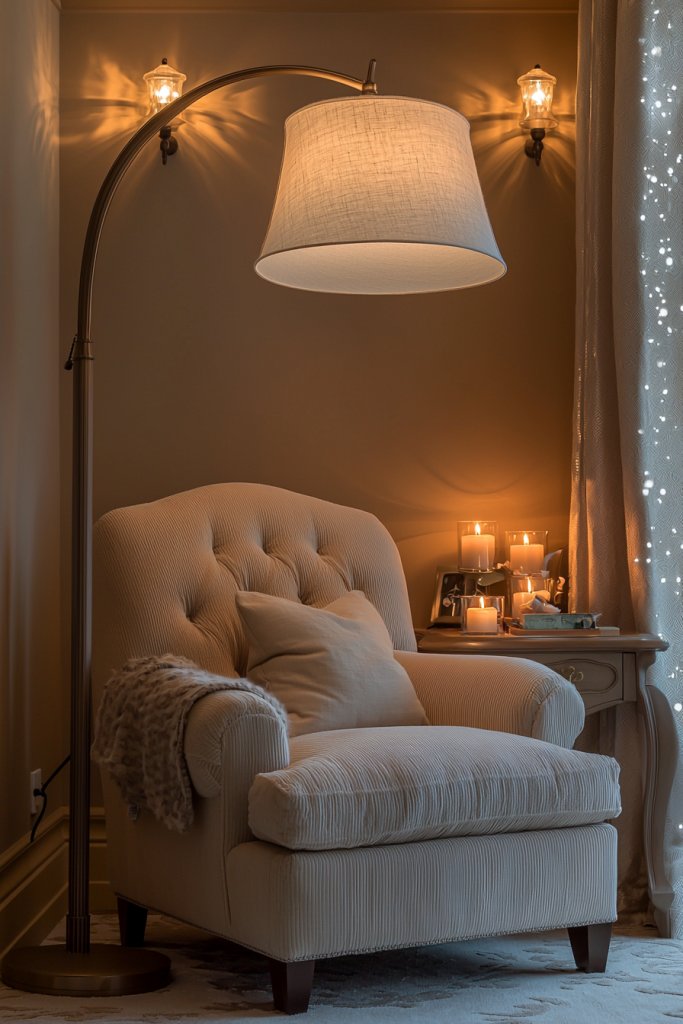
Lighting plays a crucial role in establishing a tranquil living room, and layering different light sources creates a warm, inviting glow that soothes the mind. Instead of harsh overhead lights, opt for a combination of soft ambient lighting, gentle task lights, and decorative accents.
Warm-colored bulbs, such as 2700K LEDs, mimic natural sunset tones, fostering a peaceful environment. Incorporate table lamps with fabric shades, floor lamps, and dimmer switches to adjust the mood effortlessly throughout the day and evening.
Imagine a space where a tall, arched floor lamp with a linen shade stands beside a plush armchair, casting a soft pool of light perfect for reading. Overhead, a flush-mount fixture with a frosted glass cover disperses gentle illumination, avoiding stark glare.
Small table lamps on side tables add intimacy, while candles or string lights can introduce a flickering, cozy ambiance. The layered lighting not only enhances visual comfort but also transforms the room into a calming retreat that adapts to your mood.
To implement this layered lighting setup, start by replacing bright ceiling fixtures with dimmable LEDs and installing dimmer switches for greater control. Add table lamps with soft, fabric shades—preferably in neutral tones—and position them strategically around the room.
Incorporate floor lamps for ambient light, especially in darker corners. For a finishing touch, include candles or LED candles on side tables to create a warm, flickering glow that invites relaxation. Always prioritize warm white bulbs to nurture a cozy, peaceful atmosphere.
3. Choose Minimalist Furniture to Reduce Clutter and Stress
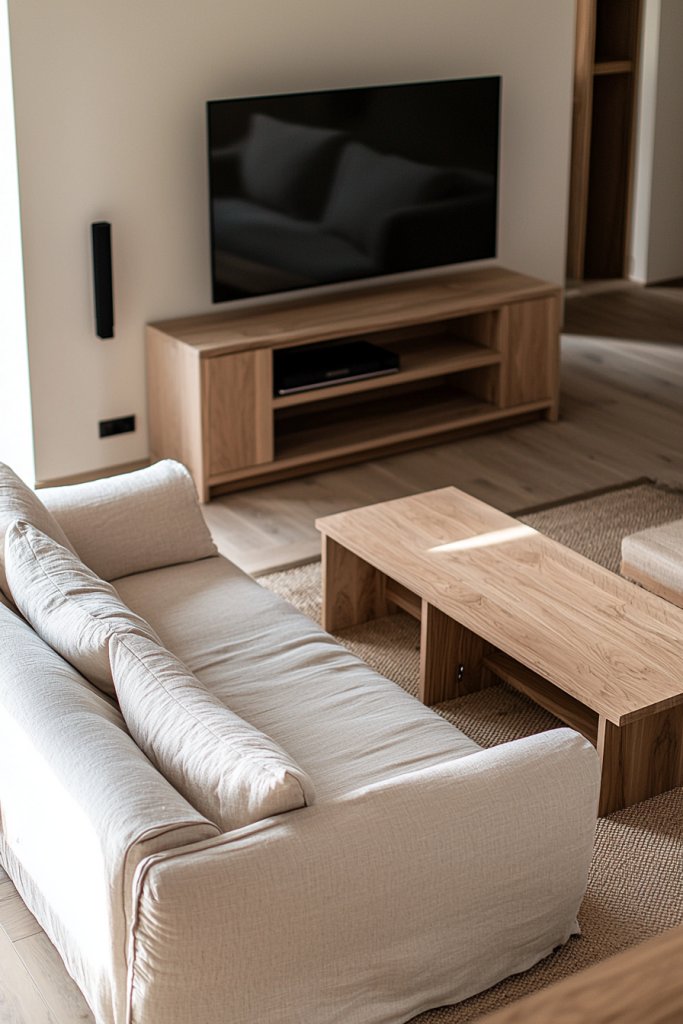
A clutter-free living room is essential for cultivating calm, and selecting minimalist furniture is a powerful way to achieve this. Focus on pieces with clean lines, simple shapes, and functional design, avoiding overly ornate or bulky styles.
Opt for furniture in neutral or muted tones that blend seamlessly into the space, creating a sense of order and openness. The goal is to minimize visual noise while maximizing comfort and practicality, making the room feel spacious and stress-free.
Picture a living room with a sleek, low-profile sofa in soft beige linen, paired with a slim wooden coffee table and a streamlined TV stand. The furniture is thoughtfully spaced to allow for easy movement, with open areas that prevent the room from feeling cramped.
Each piece has a purpose, and the lack of excess decoration keeps the environment uncluttered. This simplicity fosters mental clarity, making it easier to relax and focus on the moment.
To recreate this minimalist setup, choose furniture with simple silhouettes—think mid-century modern sofas, slim-profile armchairs, and functional storage units. Use materials like light wood, metal, or neutral upholstery.
Keep surfaces clear of unnecessary objects, and store away items in built-in cabinets or hidden storage to maintain an orderly look. Remember, less is more: select quality pieces that serve a purpose, and resist the urge to fill the space with unnecessary decor.
4. Use Textured Textiles Like Cozy Throws and Cushions
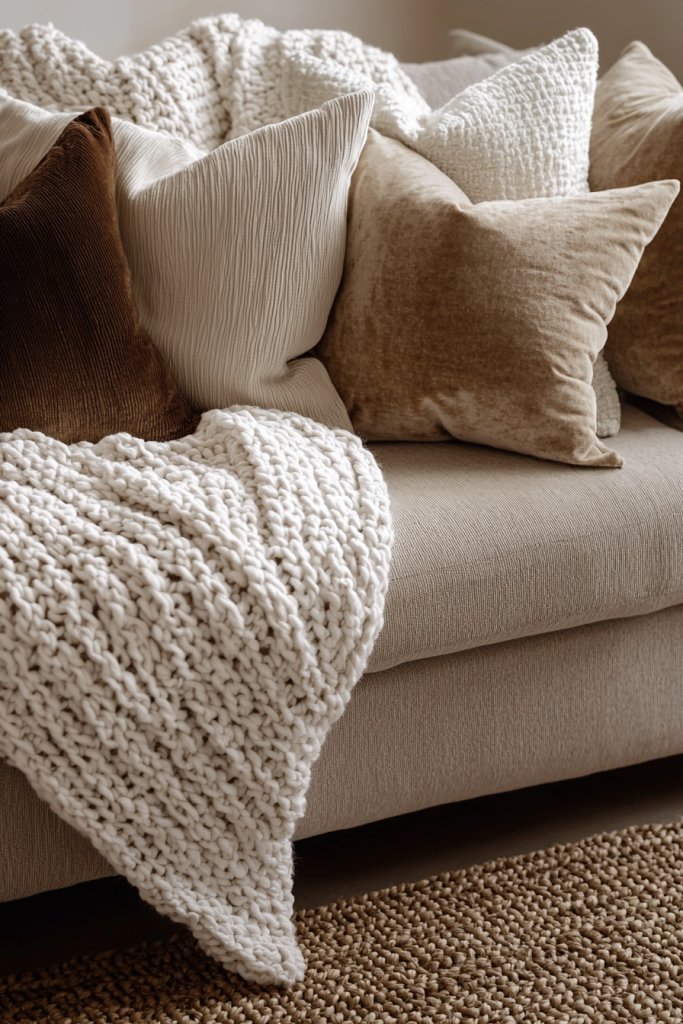
Adding textured textiles transforms a living room into a warm and inviting sanctuary by engaging the sense of touch. Cozy throws, cushions, and rugs in diverse textures bring depth and visual interest without disrupting the room’s calming aesthetic.
Opt for natural, tactile fabrics such as chunky knit throws, soft linen cushions, or woven rugs that beckon touch and provide sensory comfort. These elements soften the overall look and invite relaxation, making the space feel homey and serene.
Imagine draping a chunky knit throw in creamy white over the back of a sofa, paired with cushions in soft velvet or woven cotton in neutral shades. A textured, jute rug adds a tactile foundation underfoot, while plush cushions in tactile fabrics create cozy nooks for lounging.
The combination of textures adds richness and depth, making the room feel layered and thoughtfully curated—an embrace for both the eyes and the senses. To incorporate textured textiles, select cozy throws in wool or chunky knit, like a beige or light grey blanket, and add cushions in linen, velvet, or boucle fabrics.
Mix different textures but stay within a neutral color palette to maintain the calming vibe. Use these textiles to soften hard surfaces like wooden furniture or tiled floors. Keep them within easy reach so you can snuggle up anytime, enhancing comfort and creating a peaceful, tactile environment.
5. Opt for Simple, Uncluttered Window Treatments

Window treatments set the tone for a calm living room, and simplicity is key to avoiding visual chaos. Choose curtains, blinds, or shades with clean lines and minimal embellishments to maintain a serene aesthetic.
Light-filtering fabrics in neutral shades allow natural light to gently diffuse into the room, creating a bright yet tranquil environment. Avoid overly busy patterns or heavy drapes that can make the space feel congested; instead, aim for sleek, understated solutions that enhance the room’s openness.
Visualize a living room with crisp, white linen curtains hanging straight from a slim rod, softly billowing in a gentle breeze. Alternatively, roller shades in a neutral tone can be pulled up completely during the day for maximum light or rolled down for privacy without disrupting the visual flow.
The simplicity of these treatments complements the room’s neutral palette and helps keep the space looking uncluttered and airy, fostering a calm and collected atmosphere. To achieve this look, opt for scroll or roller shades in light-filtering fabrics like linen or sheer cotton, which can be easily operated and cleaned.
For a more polished appearance, choose slim, unobtrusive curtain rods in matte metal or wood. Keep window coverings neutral and free of heavy patterns or fringes. Regularly tidy and maintain the window treatments to preserve their clean, minimalist look, and create a peaceful view that invites relaxation.
6. Incorporate Natural Materials such as Wood and Stone
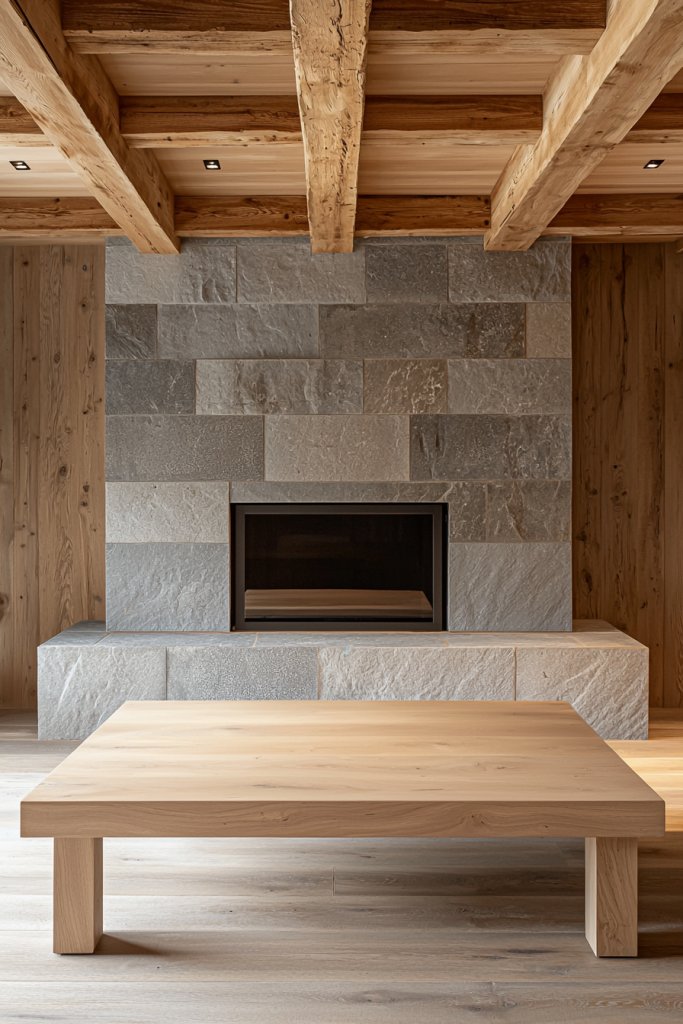
Bringing natural materials into your living room instantly creates a sense of calm and grounding, making the space feel warm and inviting. Using wood and stone introduces organic textures and earthy tones that connect your interior with the outdoors, fostering tranquility and comfort.
Imagine a light oak coffee table with a smooth, matte finish paired with a stone fireplace surround in soft gray hues. Textured wooden beams across the ceiling or a reclaimed wood accent wall add rustic charm, while smooth marble or slate tiles underfoot enhance the tactile experience.
These materials evoke a subtle sensory richness—cool stone contrasts with warm wood, and their natural grains and imperfections lend an authentic, unpretentious vibe. The overall effect is a serene environment that feels both timeless and effortless, perfect for unwinding.
To incorporate these elements, start with a statement piece like a wood coffee table or a stone accent feature. Opt for sustainably sourced wood in light shades such as ash or oak, and choose stone tiles or decorative objects in neutral tones like gray, beige, or soft brown.
You can find reclaimed wood furniture or stone accessories at local craft markets or online sustainable shops. Keep the look simple: pair your wooden elements with plush textiles in neutral shades, and avoid overly ornate finishes to preserve the calm, natural aesthetic.
7. Incorporate Open Space with Strategic Furniture Placement

Creating an open, airy living room is key to fostering a sense of calm and allowing natural light to flow freely throughout the space. Thoughtful furniture placement helps avoid clutter and encourages a relaxed, inviting atmosphere that feels spacious yet cozy.
Visualize a layout where a plush sofa faces a low-profile media console, with enough space around each piece to breathe. Keep larger furniture pieces away from pathways to avoid congestion, and position seating to promote easy conversation and relaxation.
Use open, uncluttered surfaces—like a sleek coffee table with only a few carefully chosen decor items—and leave plenty of room for movement. Incorporating negative space around furniture allows your eyes to rest and emphasizes the room’s calming simplicity.
The overall effect is a balanced environment where every piece has room to ‘breathe,’ making the space feel more expansive and peaceful. To achieve this, measure your living room carefully and choose furniture with slender profiles or low backs to maximize openness.
Arrange seating in a way that creates clear pathways and avoids overcrowding, possibly using a modular sectional or a combination of chairs and a sofa with enough space between. Use furniture with light-colored legs or minimalist designs to keep the room feeling open. Remember, less is more—prioritize quality over quantity, and only include essentials to maintain a calm, uncluttered vibe.
8. Add Calm, Monochromatic Wall Art and Decor
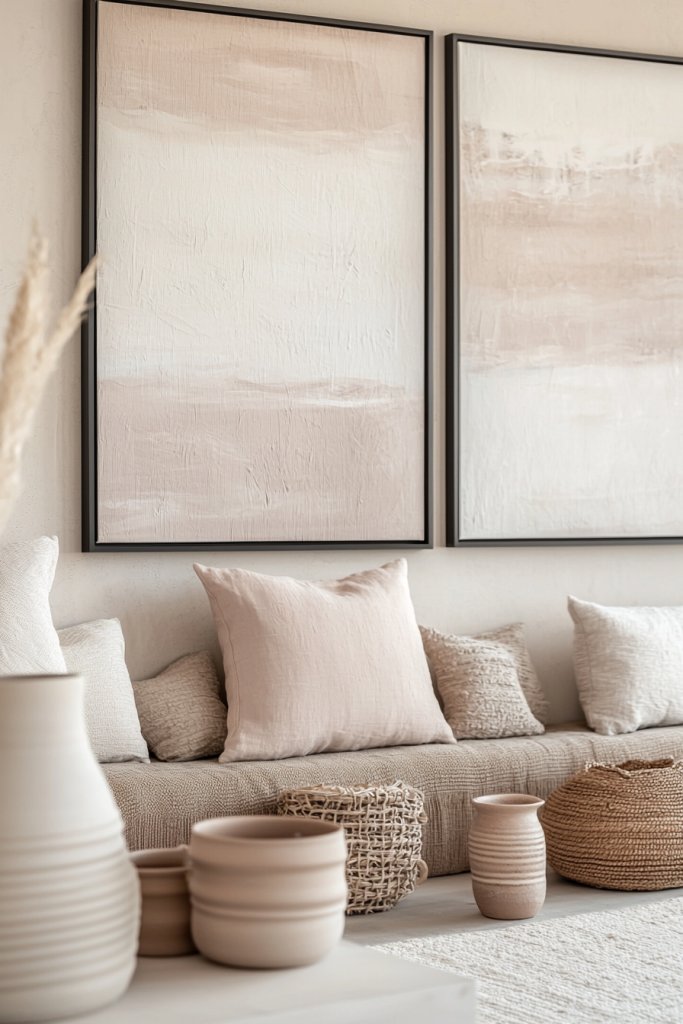
Harmonious, monochromatic decor creates a soothing visual flow that instantly reduces overstimulation and promotes relaxation in your living room. Choosing artwork and decor in similar shades ensures a cohesive look that feels serene and balanced.
Picture a wall adorned with large-scale, abstract prints in soft shades of blush, beige, or muted gray. Keep frames simple and unobtrusive—think sleek black or white borders—that complement the overall color palette.
Incorporate decor accents like ceramic vases, textured throw pillows, or woven baskets in matching tones, creating a layered but unified aesthetic. This subtle variation in shades provides visual interest without overwhelming the senses, allowing your eyes to rest comfortably.
The overall ambiance is one of quiet elegance, promoting calmness and focus. To implement this, select artwork that features a monochromatic color scheme—opt for prints, photographs, or abstract designs in shades that match your walls or textiles.
Use a neutral color palette for decorative objects—think soft creams, taupes, or light grays—placing them thoughtfully around the room. Keep framing and mounting simple, and avoid overly busy patterns or contrasting colors. This approach creates a harmonious environment where every element supports a peaceful, cohesive look.
9. Use Gentle, Earth-Tone Rug Designs to Anchor the Room
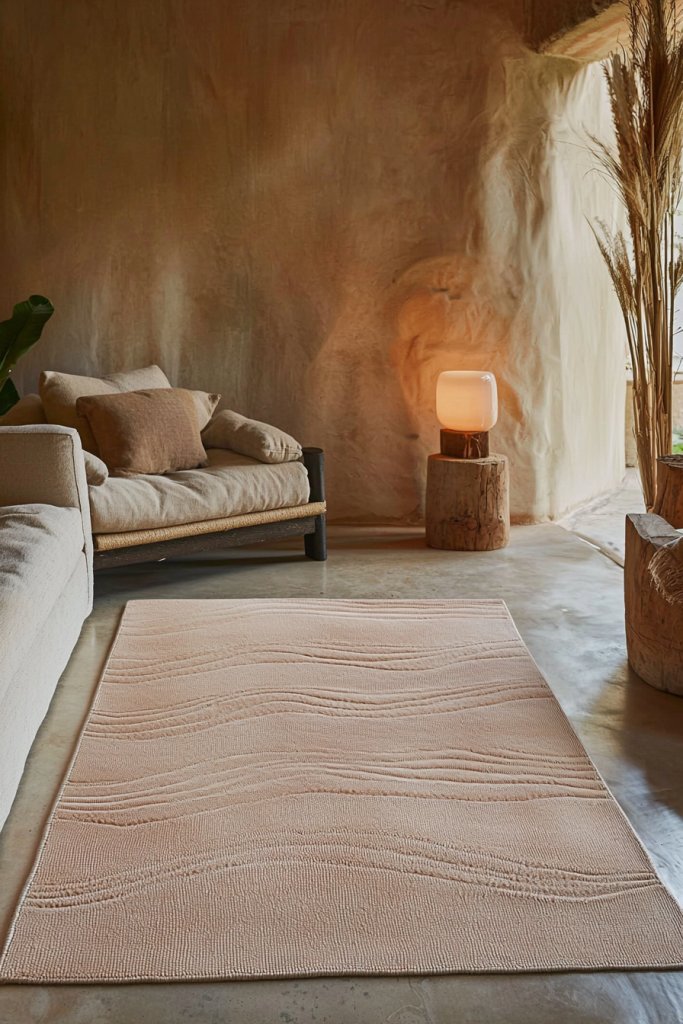
A soft, earth-tone rug acts as a calming foundation for your living room, adding warmth and texture while tying the space together visually. Choosing the right pattern and color ensures your space remains serene and inviting.
Picture a plush rug in warm beige, taupe, or muted terracotta with subtle, organic patterns like gentle waves or abstract shapes. Its tactile softness invites barefoot comfort, and the neutral tones complement other natural elements in the room.
The rug’s texture and understated design provide a visual anchor, grounding furniture and decor in a peaceful palette. It also absorbs sound, reducing echoes and enhancing the room’s tranquility.
Overall, this rug creates a cozy, cohesive atmosphere where every element feels harmonious. For easy implementation, look for rugs made from natural fibers like wool, jute, or sisal, which add texture and sustainability.
Choose a size that comfortably fits under your main seating area, leaving a border of visible flooring around it to enhance the feeling of openness. Opt for muted shades and simple patterns that blend seamlessly with your existing color scheme. To keep your space looking fresh and calm, pair your rug with neutral upholstery and minimal decorative accents, ensuring the room remains a peaceful retreat.
10. Incorporate Built-In Storage to Keep Surfaces Clear
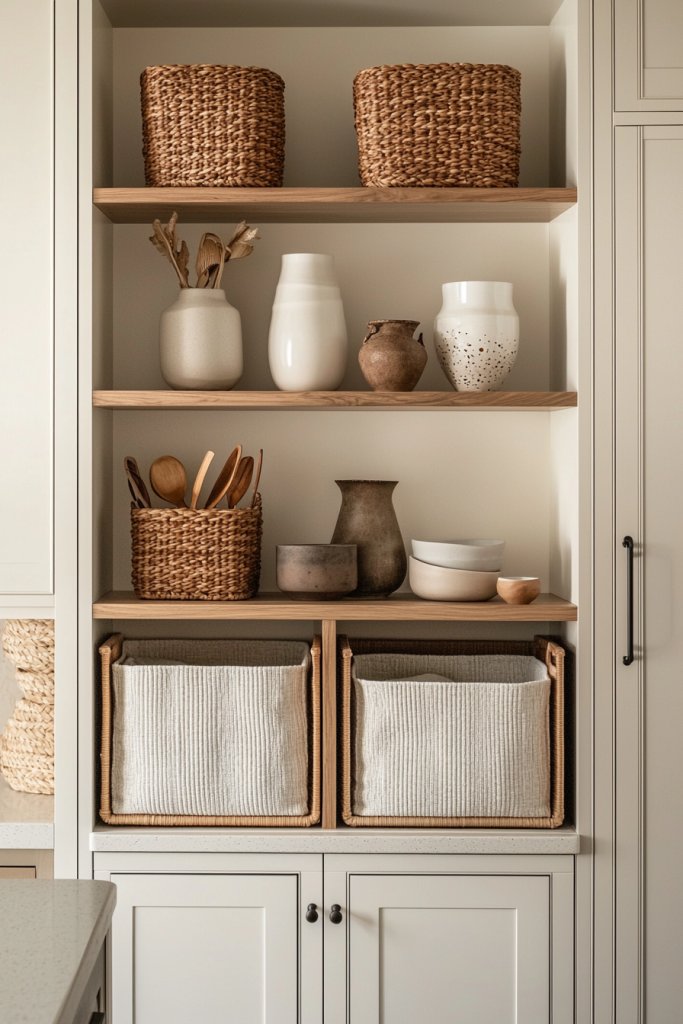
Clutter-free surfaces are essential for maintaining a calm and organized living room, and built-in storage solutions help achieve this effortlessly. They seamlessly blend into your space while offering a practical way to hide everyday items.
Imagine sleek, custom cabinetry or floating shelves integrated into walls, providing discreet compartments for books, electronics, or decorative objects. When surfaces are kept clear, your space immediately feels more open and peaceful.
Use woven baskets or fabric bins within these storage units to conceal clutter, adding texture and warmth. These built-ins also allow you to display a curated selection of calming decor—like ceramic vases or candles—without overwhelming the room.
The result is a tidy, serene environment that promotes relaxation and mindfulness. To incorporate built-in storage, start by assessing your space and planning where to add shelves or cabinets.
Choose simple, minimalist designs in neutral finishes—think matte white, soft wood tones, or muted grays—that won’t distract from the calm aesthetic. Use versatile storage containers like woven baskets or sleek boxes to keep smaller items organized.
For a DIY approach, consider installing floating shelves or modular cabinetry, or consult a professional for custom solutions. Maintaining a habit of regular tidying ensures your surfaces remain clutter-free, preserving the room’s tranquil vibe.
11. Use Aromatherapy Diffusers with Soothing Scents
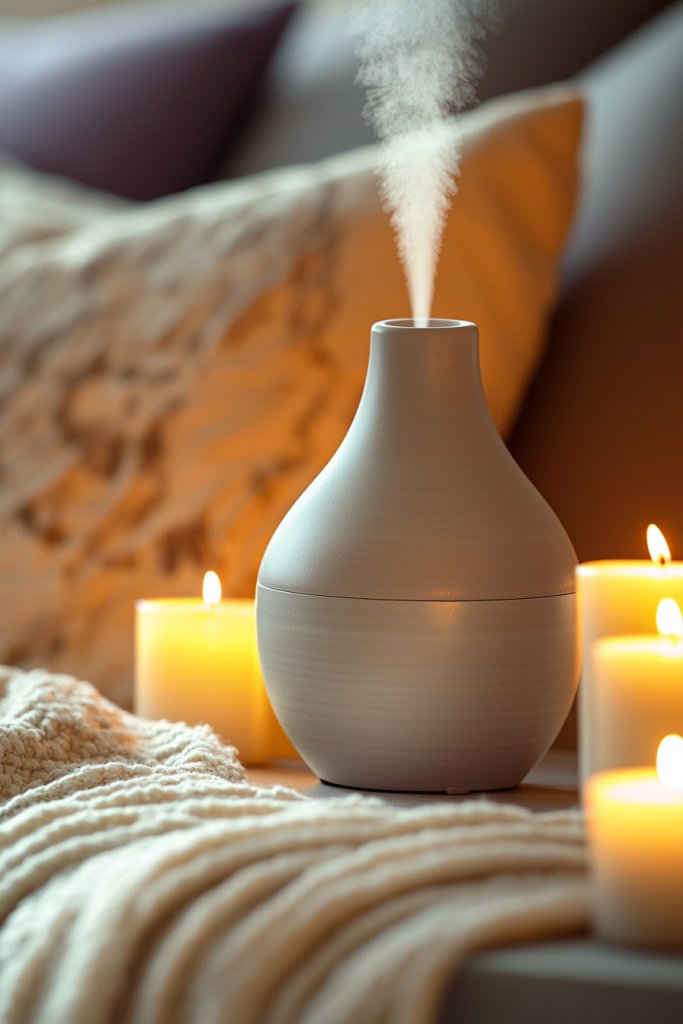
Creating a calm and inviting living room isn’t just about sight—it’s also about engaging the sense of smell. Aromatherapy diffusers filled with essential oils like lavender, chamomile, or eucalyptus can transform your space into a tranquil retreat, helping to reduce stress and promote relaxation.
This simple addition can turn your living room into a sanctuary of peace, especially after a hectic day. Imagine a sleek ceramic diffuser sitting on a side table, gently releasing a mist of lavender and vanilla, filling the room with a soft, calming aroma.
The scent lingers subtly, blending with the natural softness of a plush throw blanket and the warm glow of nearby candles. The diffused aroma creates a multi-sensory experience that promotes mental clarity and serenity, making your living space feel more like a calming retreat than just a room.
Getting started is easy: choose an essential oil blend that resonates with you—lavender, chamomile, or sandalwood are popular choices. Fill your diffuser with clean water, add 4-6 drops of your preferred oil, and turn it on.
Place it on a side table or shelf where it can gently disperse the scent throughout the room. For added ambiance, combine it with soft lighting or a few decorative ceramic bowls filled with dried herbs or potpourri for a layered calming effect.
12. Include Soft, Decorative Candles for a Warm Glow
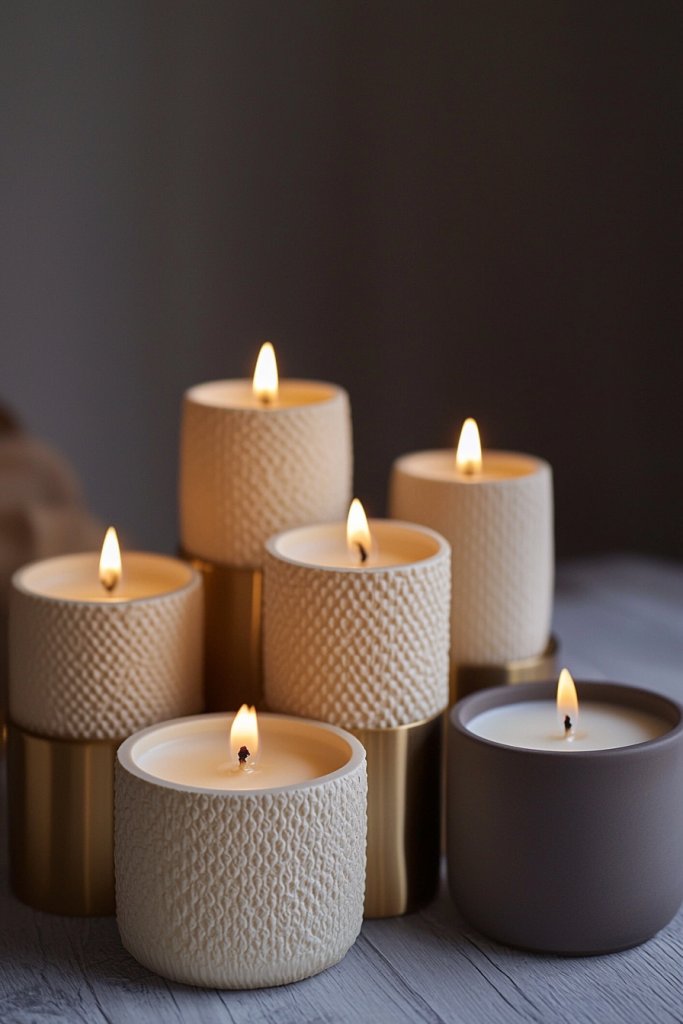
Nothing creates a cozy, calming atmosphere like the soft flicker of candles. Decorative candles in subtle shades like cream, blush, or soft gray, arranged in elegant holders or clustered on a coffee table, invite a warm, gentle glow that instantly soothes the mind.
Their flickering light adds a layer of serenity and comfort, perfect for unwinding or setting a tranquil mood. Picture a cluster of textured, cream-colored candles in varying heights, nestled in minimalist brass or matte ceramic holders.
As they burn, the room is bathed in a gentle, amber hue, while the soft scent of vanilla or sandalwood drifts through the air. The gentle crackle of a nearby candle or the warmth of their glow makes the space feel inviting and peaceful, encouraging relaxation and a sense of calm.
To incorporate candles effortlessly, select a few elegant styles—think tapered, pillar, or votive—that complement your decor. Place them on a decorative tray or in a shallow dish to catch wax drips.
Light them during evenings or quiet mornings, and turn off harsh overhead lights to allow their glow to take center stage. Always practice safety by never leaving burning candles unattended, and consider battery-operated flameless options for added peace of mind.
13. Create a Focal Point with a Calming Accent Wall
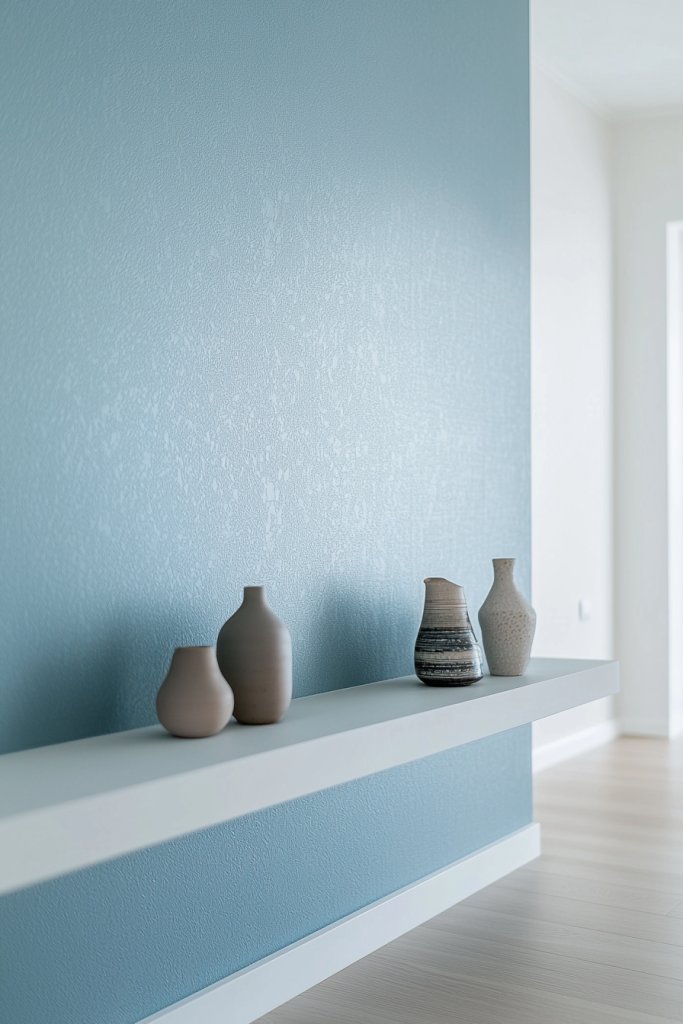
A calming accent wall serves as a visual anchor, drawing the eye and setting the tone for serenity in your living room. Using soft, soothing colors like pale blue, muted taupe, or gentle gray, this wall transforms an ordinary space into a sanctuary of calm.
It’s a simple yet powerful way to add personality without overwhelming the senses. Visualize a single wall painted in a matte, light blue hue, complemented by subtle textured wallpaper or a smooth, solid color finish.
The surface is uncluttered, perhaps accented with a sleek, minimalist shelf or a few well-chosen decorative objects that reinforce the tranquil theme. This focal point creates a sense of order and calm, making the entire room feel more cohesive and restful.
Implementing this idea is straightforward: choose a calming paint color or wallpaper that suits your space, and prepare the surface by cleaning and priming it. Use painter’s tape for clean edges and apply two coats for even coverage.
Keep the rest of the decor simple—neutral furniture, soft textiles, and minimal accessories—to enhance the peaceful effect. This subtle transformation can dramatically elevate the room’s tranquility with minimal effort.
14. Incorporate Abstract or Nature-Inspired Artwork for Visual Rest

In a calm living room, artwork acts as a visual lullaby—quiet, soothing, and free of overwhelming details. Abstract pieces in soft, muted tones or nature-inspired prints with gentle organic shapes help create a sense of visual rest, preventing cluttered or busy decor from disrupting the peaceful vibe.
These artworks serve as calming focal points that enhance the room’s overall serenity. Imagine a large, framed print featuring flowing watercolor shapes in shades of soft green, beige, or blue, hung above a neutral sofa.
Alternatively, a series of smaller, nature-inspired photographs—like gentle waves or blurred forest scenes—add subtle interest without overwhelming the senses. The artwork’s subdued palette and simple framing contribute to a harmonious, restful environment.
To incorporate such art, choose pieces that evoke calm—think gentle curves, soft color transitions, or blurred textures. Select frames in natural wood or matte finishes that complement your decor.
Hang the artwork at eye level on a prominent wall, and keep surrounding decor minimal. This approach ensures the art acts as a peaceful visual anchor, reinforcing the room’s tranquil atmosphere.
15. Choose Low-Profile Furniture for a Sense of Openness
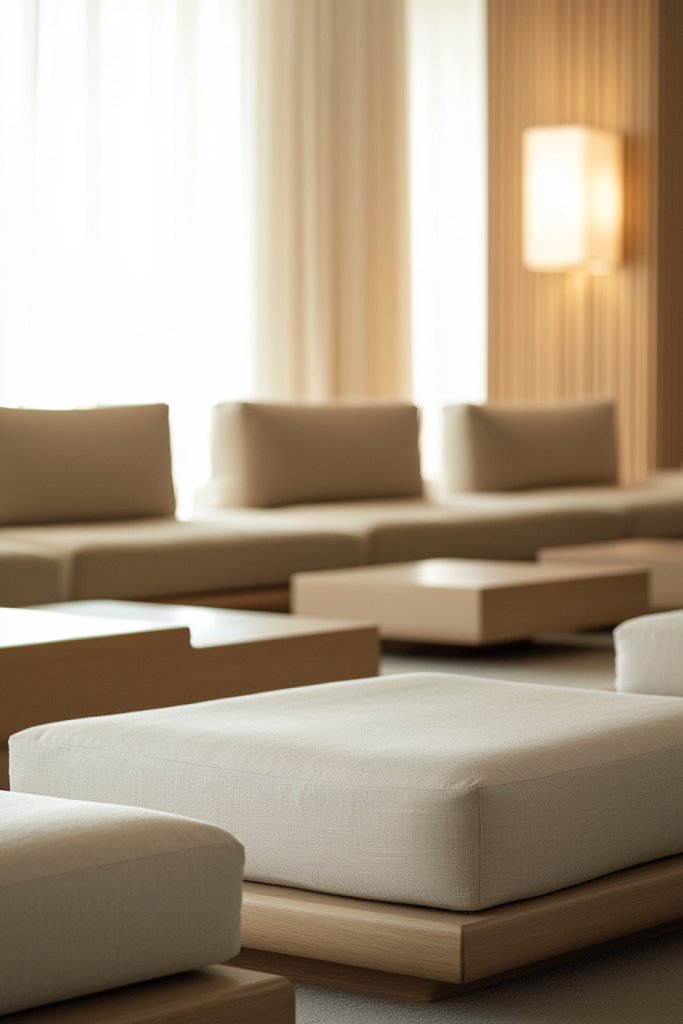
Low-profile furniture enhances the feeling of spaciousness and ease in a living room designed for calm. Pieces with sleek, minimalist lines and low heights prevent the space from feeling crowded, allowing for unobstructed views and a more relaxed, open atmosphere.
This choice fosters a sense of freedom and serenity, making the room inviting and uncluttered. Picture a low, plush sofa in a soft beige or pale gray, paired with a simple, low coffee table made of natural wood.
The furniture’s low height encourages a relaxed posture and makes the room feel more expansive. Complement this with a few carefully chosen decorative objects—like textured cushions or a cozy throw—placed within easy reach without creating visual clutter.
The overall effect is a peaceful, airy space that invites lounging and quiet conversation. To implement this, select furniture with low profiles—sofas that sit close to the ground, low tables, and minimalistic side chairs.
Focus on pieces with clean lines and neutral tones for maximum calming effect. Keep surfaces clear and avoid bulky, high-backed furniture to maintain openness.
If space is limited, consider modular or multi-functional furniture that maximizes comfort without sacrificing the room’s airy feel. This approach helps craft a living room that feels both serene and spacious.
16. Use Symmetry in Furniture and Decor for Balance
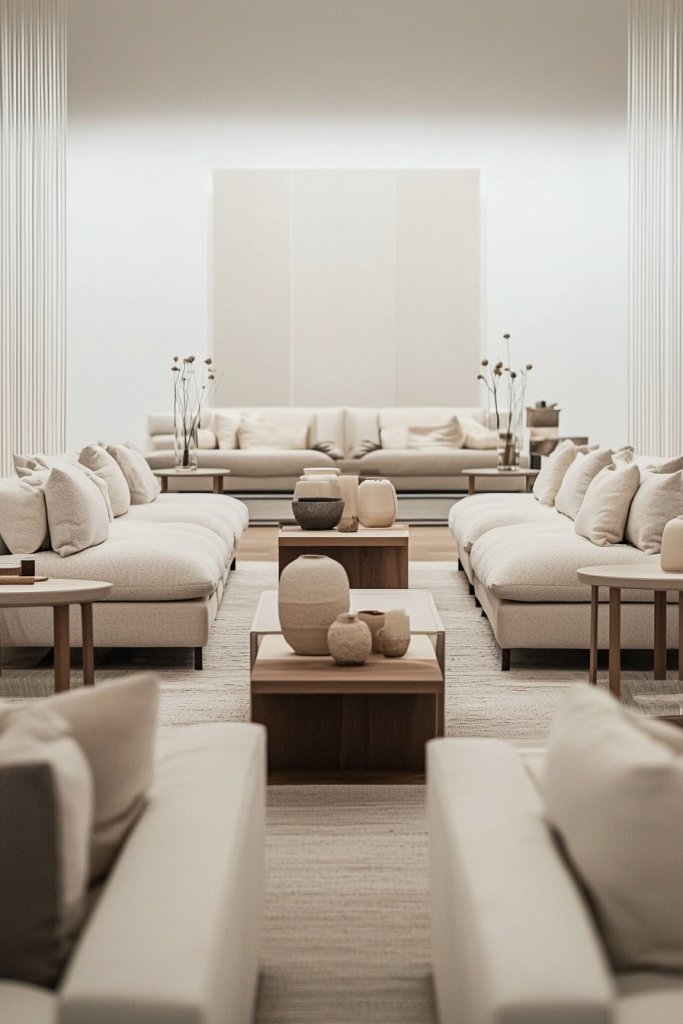
Creating a sense of harmony in your living room is essential for fostering calm and relaxation, and symmetry is one of the most effective ways to achieve this. When furniture and decor are arranged in a balanced, mirror-like fashion, the space naturally feels more orderly and peaceful, reducing visual chaos and promoting mental ease.
Symmetry also helps to create a cohesive aesthetic, making the room appear thoughtfully curated and inviting. Imagine two matching armchairs flanking a central coffee table, each adorned with identical cushions in soft, neutral tones like beige or light gray.
On the wall behind, symmetrically hung artwork or framed photographs mirror each other perfectly, while side tables and lamps are evenly spaced on either side. The overall effect is a tranquil, balanced space where the eyes can rest comfortably, and the mind can relax without distraction.
Subtle elements like matching vases or decorative bowls further reinforce the symmetrical harmony, creating a serene environment. To implement this, start by choosing pairs of furniture or decor items that can be placed in mirror positions—such as identical chairs, side tables, or lamps.
Arrange these items at equal distances from the room’s center or focal point. Keep the color palette light and neutral to enhance the sense of calm.
As a beginner, focus on simple symmetry, like balancing two identical cushions or lamps, and gradually incorporate larger symmetrical arrangements as you become more comfortable. This approach transforms your living room into a peaceful retreat with minimal effort.
17. Incorporate Gentle Curves in Furniture and Decor Elements

Soft, flowing curves add a gentle, organic rhythm to a living room, making the space feel more inviting and less rigid. Curved furniture and decor elements evoke a sense of calm and harmony, steering away from sharp angles that can sometimes feel harsh or overwhelming.
Incorporating rounded shapes encourages a relaxed atmosphere, perfect for creating a sanctuary of tranquility. Picture a plush, rounded sofa upholstered in a muted, earthy tone like taupe or blush pink, paired with a coffee table featuring a smooth, oval top in light oak.
Curved side tables or a gently arched bookshelf can subtly soften the room’s lines, while decorative accessories like rounded vases or ceramic sculptures add tactile interest. The overall aesthetic emphasizes fluidity and comfort, inviting you to unwind and feel at ease.
Textured textiles such as a chunky knit throw with rounded edges or soft, curved cushions further enhance the cozy, flowing vibe. To bring this idea to life, select furniture pieces with rounded silhouettes—think arched armchairs, circular mirrors, or oval rugs.
Combine these with accessories featuring soft, curving shapes, and avoid sharp corners where possible. For a beginner, starting with a curved sofa or a rounded side table is a simple step, and layering with textiles like a softly draped throw or curved cushions will amplify the calming effect. This approach helps create a living space that feels gentle on the eyes and soothing to the soul.
18. Add a Cozy Reading Nook with a Comfortable Chair and Blanket
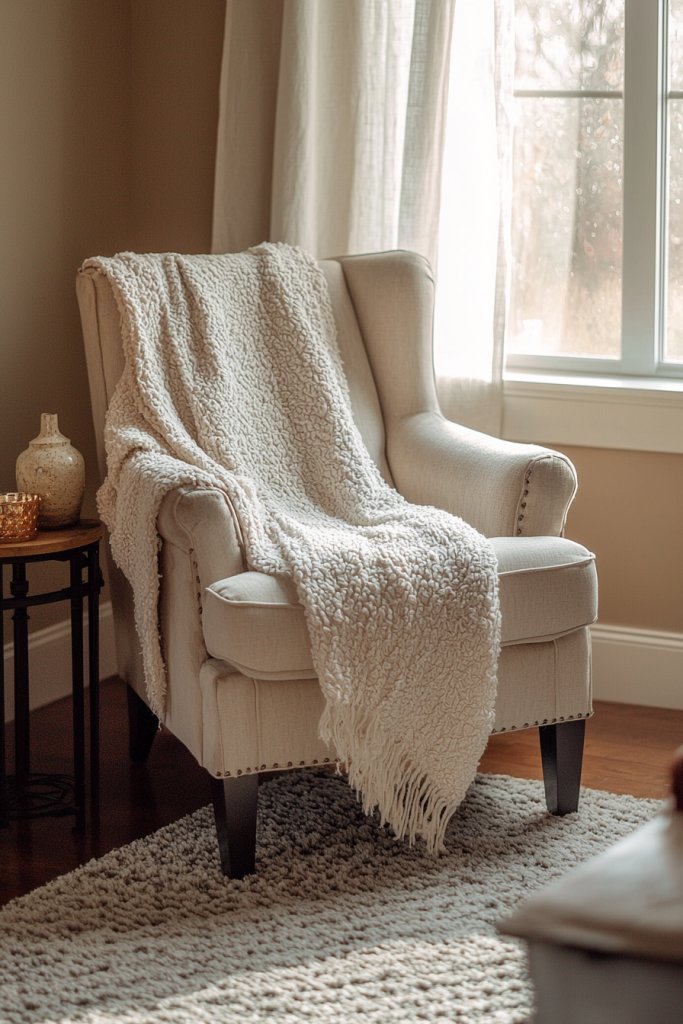
Transforming a corner of your living room into a cozy reading nook invites relaxation and quiet moments of introspection. This small, intimate space becomes your personal sanctuary, encouraging calm through comfort and simplicity.
It’s a perfect way to add a calming retreat within your larger living area, making everyday routines more mindful and restorative. Visualize a soft, overstuffed armchair in a neutral fabric like linen or boucle, positioned beside a small side table with a warm-toned lamp.
Drape a plush, chunky knit blanket over the chair’s arm, and add a few textured cushions in calming shades such as muted green or warm beige. A soft rug underneath, like a low-pile wool or jute, grounds the space.
The scent of a nearby candle or a gentle aroma diffuser enhances the cozy atmosphere, while natural light filtering through sheer curtains makes the nook feel inviting at any time of day. Getting started is simple: choose a comfortable chair with supportive cushions, and gather a cozy throw blanket and a small side table for your favorite book and a cup of tea.
Add a soft, textured rug beneath the chair, and consider placing a warm light nearby. As a beginner, focus on creating a dedicated corner with these essentials, and personalize it with your favorite textures and colors. This small retreat offers a peaceful pause amid daily life, fostering calm and comfort.
19. Use Mirrors to Enhance Natural Light and Space

Mirrors are a powerful tool for creating the illusion of more space and enhancing natural light, key elements in design for calm and serenity. When strategically placed, mirrors reflect daylight and interior textures, making rooms feel brighter, more open, and inviting.
They also add depth and visual interest, transforming a simple living room into a soothing, airy retreat. Imagine a large, frameless mirror leaning against a wall opposite a window, reflecting soft daylight that floods the room.
Alternatively, a set of smaller, decorative mirrors with simple, understated frames can be grouped artfully on a feature wall. The reflective surfaces bounce light around, brightening dark corners and emphasizing the room’s tranquil color palette—think soft whites, warm beiges, and gentle pastels.
The visual expansion created by mirrors helps to reduce feelings of confinement, making your space more relaxing and breathable. To implement, choose a mirror that complements your decor style—whether sleek and modern or rustic and textured.
Position it near windows or in areas where it can reflect natural light throughout the day. For a beginner, hanging a single large mirror or leaning a full-length mirror against the wall is a straightforward option. Regular cleaning ensures clarity and maximum light reflection, giving your living room a fresh, open, and calming atmosphere that feels larger and more welcoming.
20. Incorporate Subtle Metallic Accents for Elegance without Overstimulation
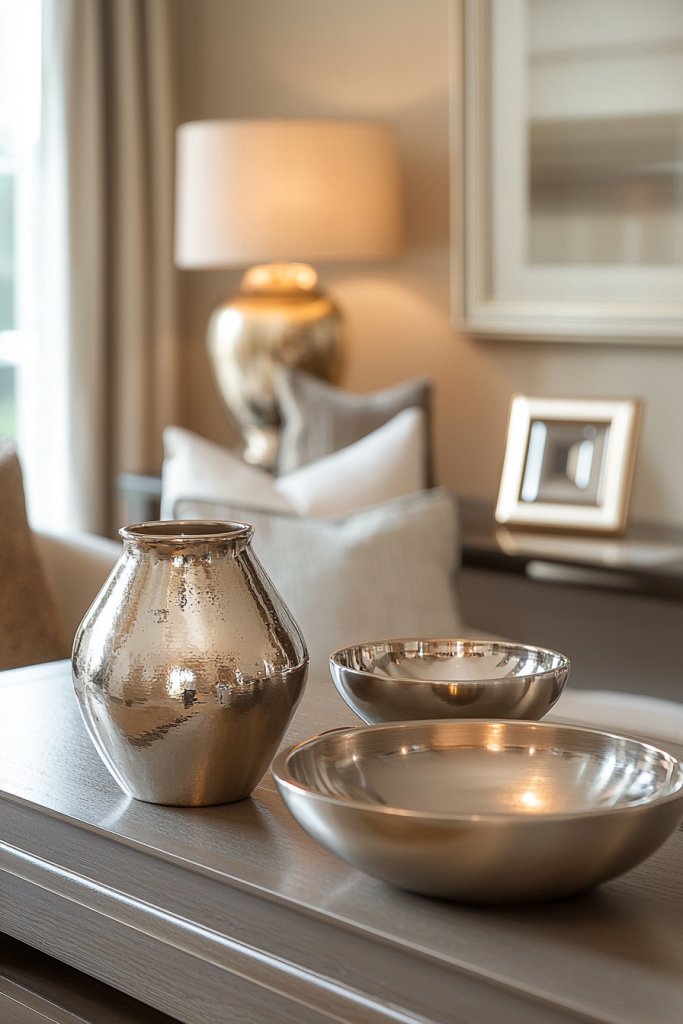
Adding delicate metallic accents introduces a touch of understated elegance to your living room, elevating the space without creating visual noise. Soft, brushed gold, matte brass, or muted silver details subtly catch the light, adding sophistication and a sense of calm.
These accents serve as refined focal points that enrich your decor, balancing modernity with serenity. Picture a sleek, brass-framed coffee table or a set of small, gold-toned decorative bowls placed on a neutral-toned shelf.
Alternatively, a metallic-finished vase with a soft matte sheen or a pair of understated metallic picture frames can add visual interest without overpowering the room. These subtle touches reflect ambient light gently, creating a warm, inviting glow that enhances the overall soothing environment.
The key is to keep metallics minimal and cohesive, ensuring they serve as accents rather than focal points. For easy implementation, select a few small elements in metallic finishes—like a tray, candle holders, or decorative objects—and place them thoughtfully on your surfaces.
Stick to a consistent metallic tone throughout to avoid visual clutter. Beginners can opt for affordable options such as matte-finished metallic accessories from home decor stores or DIY projects with metallic spray paint. When used sparingly, these accents elevate your living room’s calm elegance, creating a balanced and refined aesthetic.
21. Incorporate Soft, Diffused Lighting with Lamps and Dimmer Switches
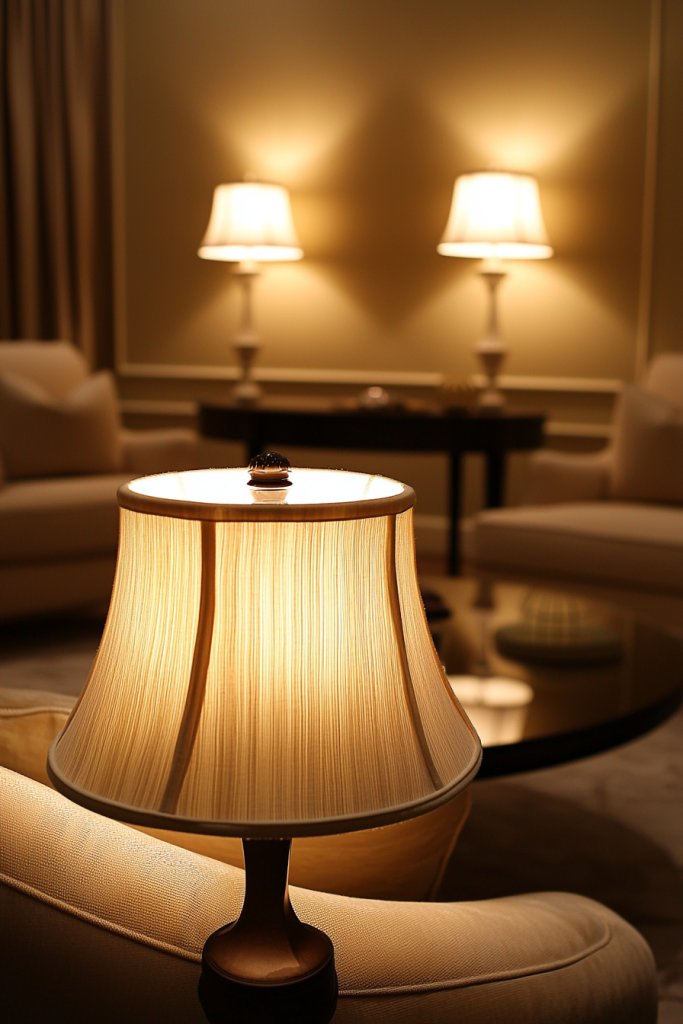
Creating a calm living room begins with lighting that feels gentle and inviting, avoiding harsh glare that can cause stress. Soft, diffused lighting transforms your space into a cozy sanctuary, perfect for unwinding after a busy day.
Using lamps with warm-toned bulbs and dimmer switches allows you to customize the ambiance effortlessly, whether you want a bright daytime feel or a low-lit, relaxing evening glow. Imagine a living room bathed in a warm, amber hue from a pair of sleek table lamps with fabric shades that soften the light.
The glow flickers gently, casting subtle shadows that highlight plush cushions and textured throws. The room feels serene, almost like a comforting hug.
The combination of different light sources—perhaps a floor lamp with a frosted glass shade and wall sconces—adds layered depth, making the space feel effortlessly balanced and tranquil. To recreate this calming effect, start by choosing warm-colored LED bulbs (around 2700K) for all your lamps.
Incorporate table and floor lamps with fabric or frosted glass shades to diffuse the light evenly. Install dimmer switches on main lights and lamps, so you can easily adjust brightness to suit your mood. Keep cords and switches discreet, and layer your lighting to achieve a soft, inviting glow that encourages relaxation.
22. Choose Clutter-Free Surfaces with Thoughtful Decorative Objects
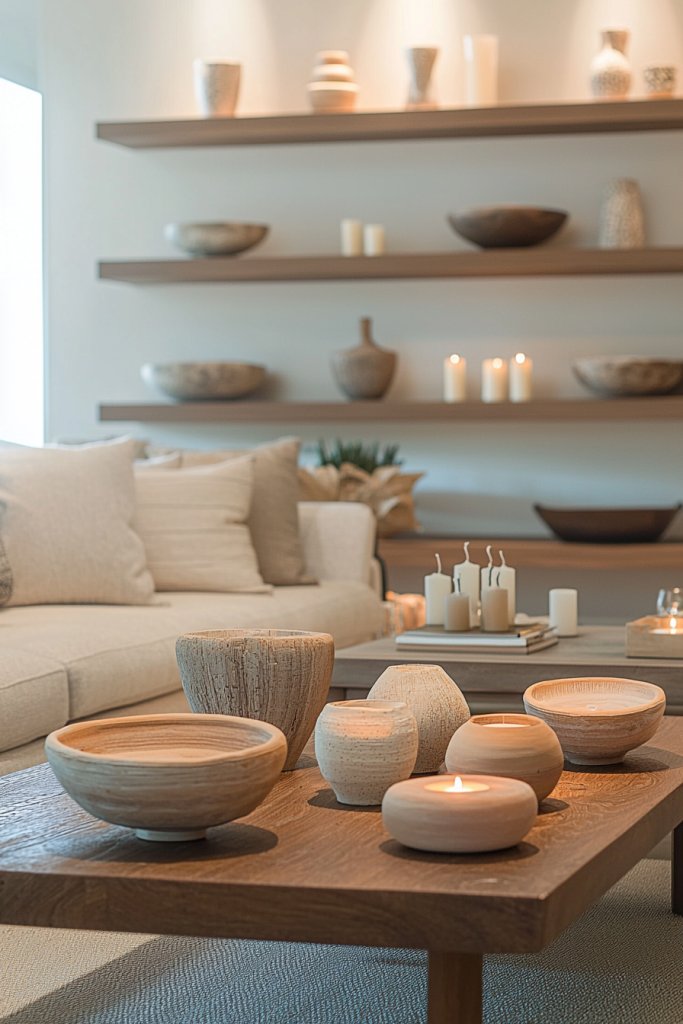
A key to fostering calm in your living room is maintaining clean, organized surfaces that serve as visual breathing space. Carefully selected decorative objects can add personality without creating clutter, helping your space feel open and serene.
The goal is to strike a balance between aesthetic appeal and simplicity, avoiding overstuffed tables or shelves. Picture a sleek coffee table with a single, elegant ceramic vase holding fresh or faux greenery, paired with a calming candle in a matte ceramic holder.
Nearby, a sideboard showcases a few carefully chosen sculptures or a minimalist clock—nothing crowded or chaotic. The surfaces are intentionally kept clear of unnecessary items, so your eye can rest on the few curated decor pieces that evoke peace and order.
Soft textures like woven baskets or linen placemats can subtly enhance the sense of calm without cluttering. Start by evaluating each surface: remove excess objects, and replace multiple small decor pieces with one or two statement items.
Use minimalist trays or decorative bowls to organize essentials. Choose decorative objects in muted tones—think matte ceramics, smooth stones, or simple glass vases—so they complement your overall color palette. This mindful approach to styling keeps your living room feeling airy, inviting, and free of visual noise.
23. Incorporate Quiet, Soothing Patterns in Upholstery and Accessories

In a calm living room, patterns should soothe rather than stimulate, creating a cohesive, restful environment. Soft, understated designs—like gentle geometrics, subtle stripes, or organic motifs—add visual interest without overwhelming the senses.
When used thoughtfully in upholstery and accessories, these patterns enhance the room’s tranquil atmosphere. Envision plush armchairs upholstered in a soft, neutral fabric with a subtle, organic leaf print or a gentle stripe pattern.
Cushions in muted earth tones, such as soft beige, gentle taupe, or dusty rose, feature quiet patterns that evoke serenity. Throw blankets with textured weaves or subtle chevrons can add tactile comfort and visual softness.
These elements work together to create a layered, harmonious look that feels restful and inviting. To implement, choose upholstery fabrics like linen, cotton, or velvet in calming shades with delicate patterns.
Select cushions and throws with subtle motifs or textures—think quilted or woven fabrics—to add depth without visual chaos. Avoid loud, busy patterns, and focus on monochromatic or tone-on-tone designs that promote a peaceful, cohesive aesthetic. This approach invites relaxation and makes your living room a true sanctuary.
24. Use Floating Shelves to Display Calm-Making Decor Items

Floating shelves are a smart way to add personality and functional storage without visual bulk, maintaining an open, airy feel. When decorated thoughtfully, they serve as curated showcases for calming decor items that contribute to a serene atmosphere.
This minimalist approach keeps clutter out of sight while adding visual interest. Imagine a set of sleek, white floating shelves with neatly arranged objects: a few carefully chosen ceramic vases, a small collection of meaningful candles, or organic-shaped sculptures in neutral tones.
These elements are spaced intentionally, allowing each piece to breathe, and are complemented by a soft, textured background like a painted wall in a gentle hue. The shelves introduce a sense of order and calm, emphasizing simplicity and thoughtful curation.
To achieve this, select floating shelves made from light wood or painted MDF for a minimalist look. Decorate with calm-colored ceramics, candles, or natural objects like polished stones—keeping the number of items minimal to avoid clutter.
Arrange objects with enough space between them for visual clarity, and consider incorporating subtle lighting above or below the shelves for a warm glow. This creates a peaceful, organized display that enhances your living room’s tranquil vibe.
25. Select a Consistent, Harmonious Decor Style for Cohesion
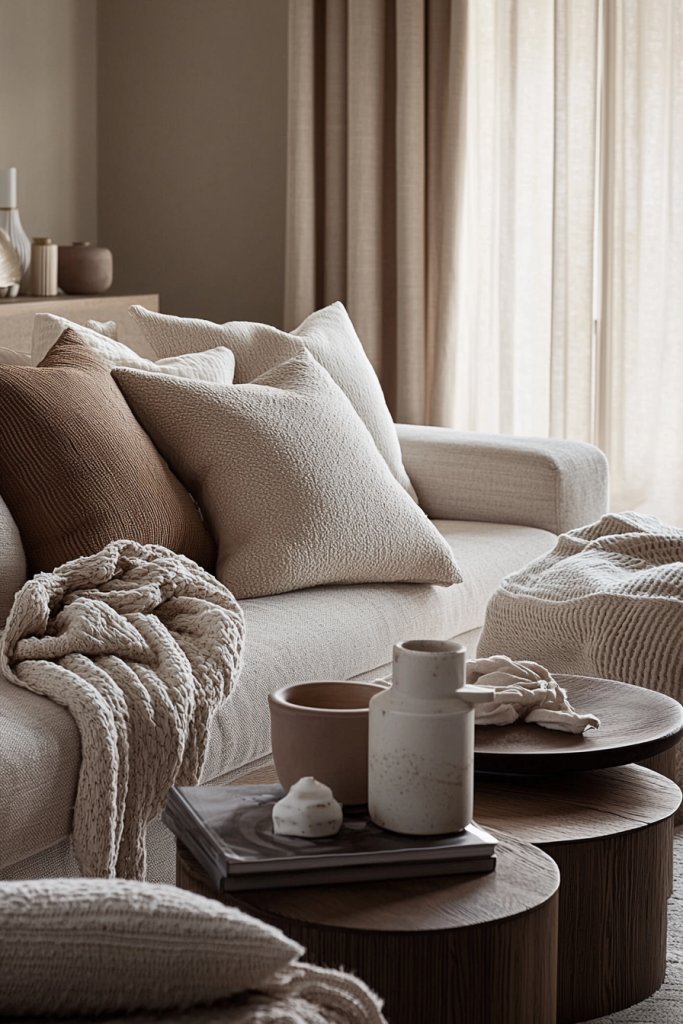
A cohesive decor style ties your entire living room together, creating a harmonious environment that feels balanced and calming. Consistency in color palette, textures, and design elements fosters a sense of order and serenity, reducing visual noise and making your space feel thoughtfully curated.
Picture a living room styled in a Scandinavian-inspired aesthetic: a neutral palette of whites, soft beiges, and gentle grays, accented by natural wood textures. The furniture features clean lines, with plush cushions and throws in complementary muted tones.
Decorative objects, textiles, and even small accessories follow the same subdued color scheme, ensuring everything works together seamlessly. The result is a tranquil space that feels unified and inviting, encouraging relaxation and mental clarity.
Begin by choosing a decor theme or style—such as minimalist, coastal, or Scandinavian—and stick to a harmonious color palette. Select furniture, textiles, and accessories that reflect this style, avoiding overly eclectic mixes.
Incorporate consistent materials, like light wood, soft fabrics, and matte finishes, and maintain a balanced distribution of textures and tones throughout the room. This intentional approach to decorating ensures your living room feels cohesive, calming, and a true reflection of your personal sanctuary.
Conclusion
Transforming your living room into a calm, inviting sanctuary is within reach by embracing neutral palettes, soft lighting, minimalist furniture, natural materials, and thoughtful organization. Incorporate soothing textures, gentle patterns, and harmonious decor to create a space that promotes relaxation and mental clarity.
Don’t hesitate to experiment with these ideas to craft a living area that truly nurtures your well-being. Start today—your serene, balanced living room awaits!
Leave a Reply